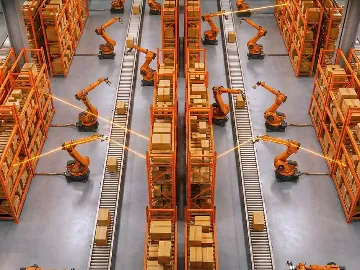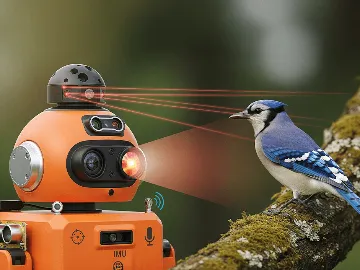An aging population, dwindling healthcare workforce, and rising costs drive the demand for robotic solutions in healthcare. Robotics is transforming patient care, surgical procedures, and medical research. By merging engineering, computer science, and medicine, robotics has opened new diagnostics, treatment, and rehabilitation horizons. Healthcare software development companies bring these innovations to life, creating the intricate software systems that power these machines. We explore the fundamental aspects of robotics in healthcare, encompassing its core components, types, applications, challenges, and prospects.
Healthcare robotics primarily encompasses automated systems operating independently, such as insulin pumps, and collaborative robots designed to work alongside humans, such as surgical assistants and rehabilitation aids.
Advancements in technology, such as improved sensors, powerful processors, and artificial intelligence, are enabling the development of sophisticated robots capable of addressing these challenges and enhancing patient care.

Benefits of robotics in healthcare
Integrating robotics into the healthcare sector promises a paradigm shift in patient care delivery, operational efficiency, and overall system optimization. The potential benefits are far-reaching, impacting both patients and healthcare providers.
Improved patient outcomes: Robotic systems enhance precision, minimize invasiveness, and ensure consistent care quality, improving patient outcomes and reducing recovery times.
Increased efficiency and productivity: Through automating routine tasks and collecting patient data, robots increase efficiency, reduce staff workload, and provide valuable insights for treatment planning, allowing healthcare professionals to focus on complex patient care.
Enhanced healthcare delivery: Robots can offer continuous care, companionship, and rehabilitation support, particularly for the elderly and those with chronic diseases. They also play a crucial role in disaster response, aiding search, rescue, and recovery efforts.
Economic benefits: Healthcare robotics has the potential to optimize healthcare economics by reducing costs through increased efficiency and improved outcomes, generating new revenue streams through innovative services, and stimulating job growth in the healthcare sector.
Robotics in healthcare by functionality
Robot functionalities encompass perception, enabling environment understanding through sensor data processing, motion planning and control for precise movement, human-robot interaction for intuitive operation, and task execution, including planning, execution, and error handling.
Healthcare robots combine physical actions, such as manipulation and movement, with complex decision-making processes driven by sensor data and human input to deliver effective patient care.
Mechanical actions of healthcare robots
Healthcare robots perform various physical tasks, often requiring precise and controlled movements. These actions can be categorized as follows:
- Manipulation: Robots interact with objects through end effectors, performing tasks like grasping, holding, cutting, and assembling. Surgical robots, for instance, utilize specialized end effectors to manipulate delicate tissues with extreme precision.
- Injection: Robots can administer injections with accuracy and consistency. This involves precise positioning, penetration, and fluid delivery/retraction. For example, insulin pumps exemplify precise injections through robotic automation. By accurately controlling insulin dosage, timing, and delivery rate, these devices mimic the body's natural insulin secretion process, aiding in diabetes management.
- Monitoring: While primarily a sensory function, it often involves physical actions such as camera positioning or sensor deployment.
Technical decision-making in healthcare robots
In healthcare robotics, technical decision-making is crucial for ensuring that robots perform tasks accurately, safely, and effectively. This decision-making process involves interpreting sensor data and executing commands from human operators or teleoperators. Here's a detailed look at how these decision-making processes work in healthcare robots:
1. Decision-making based on sensor information
Healthcare robots have various sensors that provide real-time data about their environment and state. This information is essential for making informed decisions and ensuring accurate and safe operations.
Components and processes:
- Types of sensors:
- Visual sensors: Cameras and vision systems capture images and video, which can be analyzed to identify objects, assess conditions, and guide movements.
- Force sensors: Measure forces applied during tasks such as grasping or surgical procedures, ensuring safe interactions with patients and tools.
- Position sensors: Track the location and orientation of robotic components, which is crucial for precise movements and alignment.
- Proximity sensors: Detect nearby objects or obstacles, helping avoid collisions and enabling safe navigation.
- Data acquisition and processing:
- Real-time data: Sensors continuously provide data processed by the robot's control system. For example, force sensors might provide feedback on the pressure applied to tissues in a surgical robot.
- Decision algorithms: Controllers and processors analyze sensor data using algorithms to make decisions. For instance, if a camera detects a misalignment, the robot's processor may adjust its position to correct the issue.
- Feedback and adjustment:
- Adaptive responses: Based on sensor inputs, robots can adapt their behavior. For example, a rehabilitation robot might adjust its resistance based on feedback from force sensors to match the patient's strength.
- Safety mechanisms: Sensors help ensure safety by detecting and responding to potential hazards. For instance, if a proximity sensor detects that a robot arm is too close to a patient's body, the robot can halt or adjust its movement.
Example: In robotic surgery, visual sensors provide detailed images of the surgical field. The robot's processor uses this data to guide precise movements of the surgical instruments, while force sensors ensure that the applied pressure is safe and effective.

Healthcare robots integrate sensors, actuators, and control systems to perform tasks like manipulation, injection, and monitoring, enabling complex interactions with the environment and patients.
2. Decision-making based on human operator/teleoperator commands
Healthcare robots can operate under the control of human operators or teleoperators, who provide commands to guide the robot's actions. This interaction involves translating operator inputs into actionable directives for the robot.
Components and processes:
- Operator interfaces:
- Control consoles: Operators input commands using interfaces such as control panels or touchscreens. For instance, a surgeon might use a console to direct a robotic surgical system.
- Remote control systems enable operators to control robots like telesurgery or telemedicine applications remotely.
- Command transmission and interpretation:
- Command input: Operators provide commands through various interfaces, specifying actions or adjustments. For example, a command might instruct a robotic arm to move to a specific position or perform a particular task.
- Processing commands: The robot's control system (controllers, processors, or SoC) interprets these commands and translates them into executable actions. This involves converting high-level instructions into precise movements or operations.
- Execution and feedback:
- Action execution: The robot performs the requested actions based on the received commands. For example, a teleoperated robot might perform a complex surgical procedure guided by the surgeon's inputs.
- Feedback loop: The robot provides feedback to the operator, such as status updates or alerts. This way, the operator can monitor and adjust the robot's actions. For instance, during a teleoperative procedure, the surgeon can receive visual feedback from the robot's cameras.
Example: In telesurgery, a surgeon remotely controls a robotic system using a console. The robot's control systems process the surgeon's commands, executing the precise movements required for the surgery. The surgeon receives real-time feedback from the robot's sensors to guide the procedure.

Robot software encompasses operating systems, control algorithms, sensor processing, communication protocols, and development tools, ensuring seamless interaction with hardware and the environment. This software underpins a robot's ability to execute tasks, often in conjunction with human operators, through interfaces like control consoles or remote control systems. Effective human-robot interaction involves command input, processing, execution, and feedback loops, enabling collaborative and precise task completion.
Diverse applications of healthcare robotics
Healthcare robotics encompasses many applications, from physical support tasks to cognitive assistance. Robots can be involved in various stages of care, including prevention, assessment, treatment, and long-term support. They can also assist healthcare staff in administrative and service roles. Let's look at the five primary areas for robot application in healthcare.
Service robots in healthcare
Service robots are designed to assist healthcare staff with non-patient care tasks. Key applications include:
- Logistics and transportation: Delivering supplies, medications, and food; moving patients on autonomous beds.
- Workforce training: Simulating patient scenarios for medical professionals.
- Laboratory automation: Optimizing pathology processes and reducing manual labor.
- Pharmacy automation: Dispensing medication accurately and efficiently.
- Sanitation: Cleaning and disinfecting hospital environments.

Assistive robots in healthcare
Assistive robots are designed to support individuals with physical disabilities in performing daily living activities. They primarily focus on enhancing mobility and manipulation capabilities.
- Mobility support: Robots like smart wheelchairs and walkers aid in navigation and independence for people with limited mobility.
- Manipulation support: Robotic arms and grippers assist with eating, dressing, and object-handling tasks.
- Rehabilitation: Robots are used in physical therapy to improve strength, coordination, and mobility.
- Wearable robots: Exoskeletons, prostheses, and orthoses enhance physical capabilities or replace lost limbs.
By providing these assistive functions, robots aim to improve disabled people's quality of life and independence.

Socially assistive robots (SARs) in healthcare
Socially assistive robots (SARs) are designed to provide emotional support, companionship, and assistance through social interaction. These robots can take various forms, from human-like to animal-inspired designs. Key functions of SARs include:
- Companionship: Providing emotional support and reducing stress.
- Therapy: Assisting in therapy sessions for conditions like autism or dementia.
- Education: Teaching healthy habits or providing information about medical conditions.
- Motivation: Encouraging physical activity and medication adherence.
SARs have shown potential in improving the quality of life for elderly individuals, people with disabilities, and children. However, further research is needed to understand their impact and effectiveness in various healthcare settings fully.

Teleoperated robots in healthcare
Teleoperated robots, or telerobots, enable remote delivery of healthcare services. These systems allow healthcare professionals to control robotic devices from distant locations, facilitating procedures like surgery, diagnosis, and treatment. Key applications include:
- Telesurgery: Performing complex surgeries remotely.
- Telemedicine: Providing consultations and diagnoses from a distance.
- Telepresence: Enabling remote presence for patient interaction and monitoring.
While challenges such as latency and network reliability exist, telerobotics can potentially expand access to specialized care, especially in remote areas.

Interventional robots in healthcare
Interventional robots assist medical professionals in performing minimally invasive procedures with increased precision and accuracy. These robots are used in various surgical specialties, such as urology, cardiology, and orthopedics. Key features and applications:
- Enhanced dexterity: Robots give surgeons greater control and precision than traditional methods.
- Minimally invasive procedures: Smaller incisions and reduced tissue damage.
- Image-guided surgery: Integration of imaging data for improved accuracy.
- Teleoperated and semi-autonomous systems: Offering flexibility in surgical procedures.
- Emerging technologies: Micro and nanorobotics have potential for advancements in minimally invasive interventions.

Artificial intelligence and robotics in healthcare
AI has significantly enhanced robotic capabilities. Unlike earlier systems reliant on mathematical calculations, AI enables robots to make decisions informed by data, probabilities, and learned experiences, mirroring human decision-making processes. These decisions are based on analysis of patterns and information rather than assumptions that lack empirical support. AI provides a framework for decision-making that can handle complexity and uncertainty more effectively than traditional rule-based systems. This integration of AI has led to more intelligent and adaptable robots in healthcare.
Transform healthcare with Conversational AI – explore its top applications now!


Success!

A survey exploring public willingness to engage with AI and robotics in healthcare revealed a strong inclination towards AI-driven diagnostic and monitoring roles. Tasks such as heart condition monitoring, blood testing, and health advice garnered significant approval. However, there was a notable reluctance towards invasive procedures like surgery and childbirth, with a significant portion of respondents expressing discomfort or unwillingness to utilize AI/robots for these purposes.

Read more: Generative AI in healthcare: Use cases and challenges
Digital twins and simulation
Digital twins and simulation have greatly improved the design and control of robotic systems. By creating virtual replicas of physical environments and robots, engineers can conduct extensive simulations and testing before deploying systems in the real world. Tools like Gazebo and SimScape provide powerful platforms for modeling complex systems, allowing for detailed analysis of dynamics, kinematics, and control algorithms.
The mathematical foundation of control systems is crucial for achieving desired performance. Techniques such as automatic, adaptive, and optimal control enable robots to respond to changing conditions, learn from experience, and make decisions that minimize errors and maximize performance. These tools and techniques have significantly accelerated the development of advanced robotic applications in healthcare, space exploration and industrial automation.
Read more: Machine Learning in healthcare: top 10 applications
Wrap-up
The convergence of robotics, artificial intelligence, and healthcare is transforming the delivery of patient care. The potential benefits of robotics in healthcare outweigh the challenges. From enhancing surgical precision to providing companionship for the elderly, robotics has the potential to transform healthcare delivery. With the advancement of technology, it is essential to prioritize ethical considerations, patient safety, and accessibility so that these innovations are used to benefit society.
The successful integration of robotics in healthcare will require collaboration between engineers, medical professionals, policymakers, and ethicists. We can unlock robotics' full potential to improve human health and well-being by fostering interdisciplinary partnerships and investing in research and development.
To fully realize the benefits of robotic technologies, healthcare organizations must consider partnering with a trusted software development company. This collaboration is crucial for designing, developing, and implementing robust software systems essential for robots' seamless operation and integration into patient care workflows. By leveraging the expertise of software development partners, healthcare organizations can accelerate the adoption of robotics in healthcare, enhance patient outcomes, and optimize operational efficiency.
Have a question?
Speak to an expert




